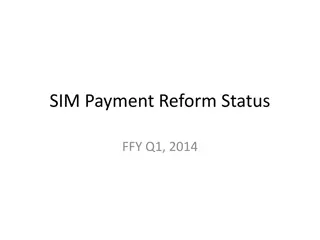Thermomechanical Analysis of Pixel-Hybrid Module by Leonardo Ribeiro
The thermomechanical analysis of the pixel-hybrid module conducted by Leonardo Ribeiro explores the challenges faced due to cycling between 213 K and room temperature, emphasizing the impact of different thermal expansion coefficients on the structure. The study involves a detailed examination of the pixel module, the box model, methodology using Finite Element Analysis, simulation constraints, and general results from multiple runs. Qualitative analyses reveal insights into material behavior and stress distribution under varying conditions.
Download Presentation

Please find below an Image/Link to download the presentation.
The content on the website is provided AS IS for your information and personal use only. It may not be sold, licensed, or shared on other websites without obtaining consent from the author.If you encounter any issues during the download, it is possible that the publisher has removed the file from their server.
You are allowed to download the files provided on this website for personal or commercial use, subject to the condition that they are used lawfully. All files are the property of their respective owners.
The content on the website is provided AS IS for your information and personal use only. It may not be sold, licensed, or shared on other websites without obtaining consent from the author.
E N D
Presentation Transcript
A thermomechanical analysis of the pixel-hybrid module Leonardo Ribeiro
Introduction Modules have to resist cycling between 213 K and RT Different thermal expansion coefficients Leads to bending of coupled structure Thermal stresses Image: https://physicsabout.com/thermal-expansion/
The Model #1:The Box Model 5 boxes Top to bottom: PCB flex ( 71% Copper and 29% Kapton), glue (Araldite),sensor (Silicon), bump bonds (Sn-3.5Ag, 20% fill factor) and RD53 chip (Silicon) 0.210 mm 0.050 mm 0.150 mm 0.025 mm 0.150 mm
Methodology Finite Element Analysis (FreeCAD) Results can be compared to Ultimate Tensile Strength (UTS) of materials UTS indicates threshold for necking and breaking Map stress and strain across module Stress = pressure Strain = relative deformation Checking references (University of Glasgow s simulation)
Simulation constraints Homogeneous materials Ambient temperature going from 293 K to - 213 K Mechanical constraint at RD53 s bottom All relevant dimensions taken from mechanical design sketches Heat flow allowed and taken into account
General Results (First Run) Aluminum bump bonds Strain on the left, maximum stress on the right Magnitudes see next slides PCB PCB Glue Glue Sensor Sensor Bonds Bonds RD53 RD53 Strain Stress
Qualitative Analysis (First Run) Soft glue expands the most, (largest strain) Stress concentrated at bump bonds (low UTS)
General Results (Second Run) Sn-Ag bump bonds Strain on the left, maximum stress on the right Magnitudes see next slides PCB PCB Glue Glue Sensor Sensor Bonds Bonds RD53 RD53 Strain Stress
Qualitative Analysis (Second Run) Soft glue expands the most, (largest strain) Stress dissipates to RD53 and PCB (edges)
Quantitative challenges 0.5 mm 0.3 mm Limited post-processing options Huge fluctuation within each layer, even for high element density Cuts at heights of 0.5 mm on the left, 0.3 mm on the right
Quantitative challenges Maximum stresses were too high due to deviations Results not symmetric about origin as expected Better post-processing needed
Stress profile (First Run) Estimate based on cuts (maximum stress value at a given height) Software constraint on step size (100 microns)
Comparative analysis (First Run) Comparison between ranges found by LBNL (from previous slide s graph) and the single data point per layer found by Glasgow: Stresses at: (in MPa) PCB Glue Sensor Bump bonds RD53 LBNL 80-90 45-80 50-230 175-260 70-175 Glasgow 85 48 220 53 70
Stress profile (Second Run) Estimate based on cuts (line along center of chip)
Comparative analysis (Second Run) Comparison between maximum stress found by LBNL (from previous slide s graph) and by Glasgow: Stresses at: (in MPa) PCB Glue Sensor Bump bonds RD53 LBNL 134 50 64 52 66 Glasgow 85 48 220 53 70
Comparative analysis LBNL Glasgow (Cunningham) Stress concentrated on PCB Maximum stress at Silicon sensor Magnitude of stresses still unclear Maximum stress quantified Semi-continuous stress profile One data point per layer Model glue as a box Model glue pattern
Conclusion Despite uncertainties, major agreement at stress values at bump bonds Allowing room for all cited errors, results diverge at PCB and silicon sensor
Next steps Finish data post-processing Refine model Shape of bonds PCB details Heat source at RD53 Wire bonds Suppot participation
















